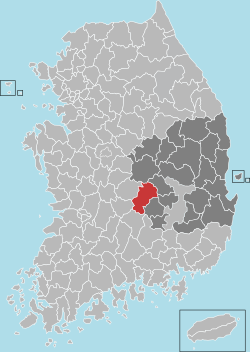Gimcheon-si
|
Gimcheon 김천시 |
||
|---|---|---|
| Municipal City | ||
| Korean transcription(s) | ||
| • Hangul | ||
| • Hanja | ||
| • Revised Romanization | Gimcheon-si | |
| • McCune-Reischauer | Kimch'ŏn-si | |
 |
||
|
||
 Location in South Korea |
||
| Country |
|
|
| Region | Yeongnam | |
| Administrative divisions | 1 eup, 14 myeon, 7 dong | |
| Area | ||
| • Total | 1,009.5 km2 (389.8 sq mi) | |
| Population | ||
| • Total | 150,000 | |
| • Density | 150/km2 (400/sq mi) | |
| • Dialect | Gyeongsang | |
Gimcheon (김천; 金泉市; Korean pronunciation: [kim.tɕʰʌn], trans., 'gold spring city') is a city in North Gyeongsang Province, South Korea. It is situated on the major land transportation routes between Seoul and Busan, namely the Gyeongbu Expressway and Gyeongbu Line railway.
In ancient times, Gimcheon was famous for its three mountains (Geumo, Daedeok, Hwangak) and two rivers (Gamcheon, Jikjicheon). During the Chosun Dynasty, Gimcheon had one out five largest markets in the region. The town has also served as the gateway and traffic hub of the Yeongnam region and is particularly proud of its patriots, history and conservative lifestyle.
The city brand slogan of Gimcheon city is 'Central Gimcheon', a recognition of the fact that it is situated almost at the center of Korea.
Symbols of the city:
Gimcheon's claim to fame is Jikjisa Temple (직지사), located at the foot of Mt. Hwangaksan. The temple was constructed in 418 (the 2nd year of King Nulji's reign, Silla Dynasty). Jikjisa is an important head temple of the Jogye Order of Korean Buddhism. This temple is in perfect harmony with the nearby valley and pine forest. The foliage in fall is particularly breathtaking. It features Birojeon Hall (also known as ‘Cheonbuljeon Hall’), in which approximately 1,000 Buddha statues are enshrined, along with a thousand year old arrowroot. Iljumun Gate, Daeungjeon Hall (one of the most famous architectural structures of the Joseon Dynasty) and a 1.63m-tall Seated Stone Buddhist Statue (Treasures No. 319) from the Unified Silla Period, can also be found on the temple grounds.
Jikjisa is believed to have been first constructed by the Goguryeo monk Ado in the year 418, long before Buddhism gained general acceptance in Silla. Jikjisa was largely destroyed during the Seven Year War in the 1590s. The reconstruction of the temple spanned from 1610 to about 1670.
Jikjisa is possibly one of the oldest temples in South Korea and it is relatively well-connected to a convenient train and bus service. Jikjisa Station is located at the foot of the mountain, along the Gyeongbu Line railroad. It is served only by local commuter trains, which run twice daily in each direction. Overnight or weekend temple stay programs are available at the main complex.
...
Wikipedia

